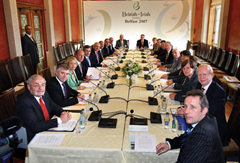The east-west connection
 The British-Irish Council’s progress is measured more in meetings than press releases, Peter Cheney finds. Supporters want to see it having a higher profile.
The British-Irish Council’s progress is measured more in meetings than press releases, Peter Cheney finds. Supporters want to see it having a higher profile.
Perhaps the quietest component of the Good Friday Agreement, the British-Irish Council (BIC for short) has been working continuously since December 1999. East-west links, though, are still seen as the poor relation to those between North and South.
The BIC was designed in the Belfast Agreement to be, as Reg Empey explains, “an expression of where unionists saw their allegiances”. The council’s eight member governments represent:
• two nation-states (UK, Republic of Ireland);
• the UK’s three devolved nations (Scotland, Wales, Northern Ireland);
• the three crown dependencies (Jersey, Guernsey, Isle of Man).
Twelve years on, its performance has been “patchy” to date, according to Empey. “It has obviously brought people together. It does work to that extent,” he comments. “It’s still the poor relation to the North/South Ministerial Council.”
He recalls how Scottish First Minister Donald Dewar gave a passionate speech at its initial meeting in December 1999. Regional and island governments have been more enthusiastic than central government, but the council does not have the same “centre of gravity or critical mass” as its North/South counterpart.
Structure
UK Cabinet Office and Irish Department of Foreign Affairs currently provide administrative support, but Empey sees a real need for a full-time standing secretariat.
Progress on this was promised in the St Andrews Agreement. The DUP wanted a Belfast base but Alex Salmond persuaded members to opt for Edinburgh. Work is still in progress but the move is strategically important to Scottish nationalists, who want their country to be the third national government after independence.
The BIC therefore offers something to unionism and nationalism. Incidentally, Empey thinks the NSMC came from nationalist fears of unionist domination but developed into something wider. As Enterprise Minister, he oversaw “probably more north-southery than anybody else”.
Co-operation, rather than integration, is the BIC’s main theme. Indeed, its warmly-worded remit is “to promote the harmonious and mutually beneficial development of the totality of relationships among the peoples of these islands.” Decisions are normally taken by consensus and governments can choose to opt out of policies.
Council agreements are implemented by working groups of civil servants. Each sector of work is supervised by a “lead administration”. Specific results have included studies into how climate change could affect the British Isles (July 2003) and the voluntary sector’s contribution to society (March 2010).
Members have agreed in principle to recognize each others’ driving disqualifications, but have not yet worked out how this would work in practice.
Profile
The council’s summits are the most public part of its work. The first since restoration took place at Stormont on 16 July 2007, with Ian Paisley and Martin McGuinness hosting Gordon Brown and Bertie Ahern. The DUP insisted on the event (pictured) taking place one day before the North/South Ministerial Council, as it claimed east-west relations had been neglected.
Apart from that, the council has had a fairly low profile. It once had its own website but no longer; pages are now hosted on the Government of Jersey’s site. The link remains www.britishirishcouncil.org
BIC meetings continued during the 2002- 2007 suspension. Northern Ireland was only one of eight members and could be represented by direct rule ministers. The NSMC, in contrast, stalled as it depended on having a cross-community delegation of northern ministers.
A summit in Edinburgh in September 2008 took place despite the Executive not meeting. Peter Robinson and Martin McGuinness attended but an NSMC summit, due the following week, was cancelled in an apparent snub to Sinn Féin.
Guernsey politician Barry Brehaut called for his island to leave the council in April 2010, to save money. “With the British- Irish Council stuff, is there anything we can do that will keep Guernsey’s profile up, but is less expensive to the community?” he asked.
For Reg Empey, though, the council has never been more relevant. Many European funding programmes are “cross-national” so the countries within the British Isles need to co-operate to get money. The BIC also has a different dynamic from the NSMC.
“You have a much greater mix of people there, all with their own administrations and their own decision-making powers, so you cannot force them about,” he comments. “Nobody has backed out of it. Everybody participates and, from that sense, it gives a platform for everybody to express their opinions on issues that affect all of us.”
Republicans relaxed
A separate British-Irish Parliamentary Assembly (BIPA) brings together legislators from each BIC member. It started life as the British-Irish Inter-Parliamentary Body in 1990 but was boycotted by unionists due to its links to the Anglo-Irish Agreement. A rebranding in 2008 ended the boycott.
It’s not a talking shop, according to Sinn Féin MLA and BIPA member Barry McElduff. The assembly works through condensed agendas. Its Environmental and Social Committee has brought out two reports on the problems facing vulnerable Irish people in Great Britain.
McElduff backs a standing BIC secretariat and would like to see “better connectivity” between it and the BIPA, so ministers can implement decisions. He also calls on unionists to support a North/South parliamentary forum, which is one of the Agreement’s missing links.
“We are working fully the institutions of the Good Friday Agreement. Our preference, of course, and our priority is North/South integration,” he adds. The BIPA website is www.british-irish.org





